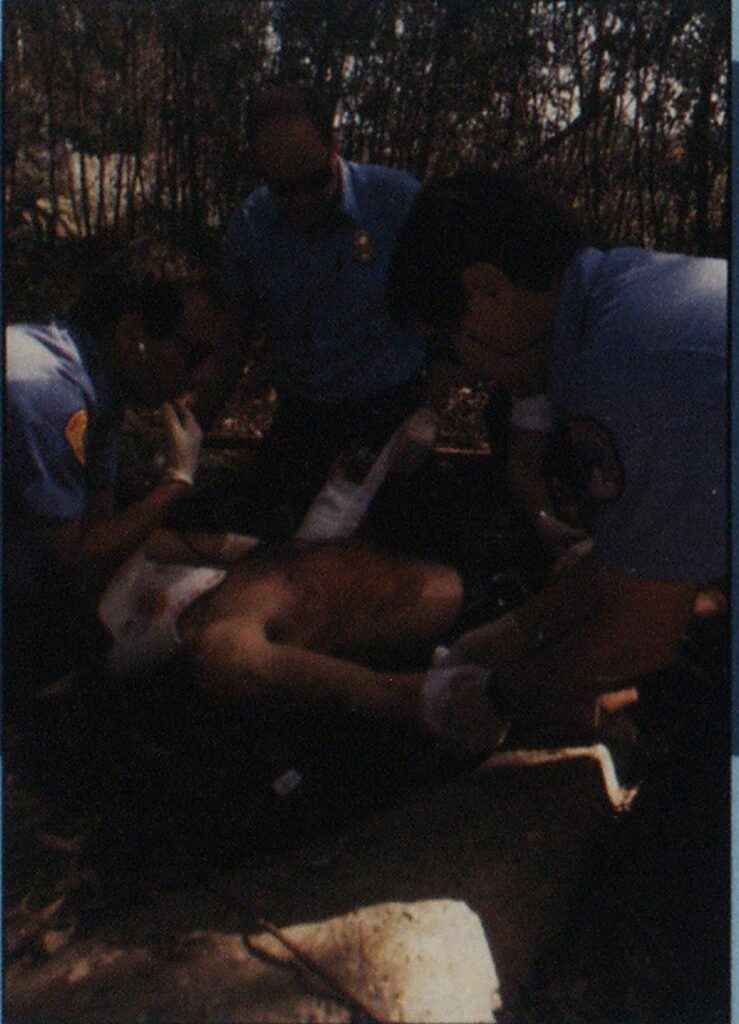
EMS POINTS TO PONDER
The EMS operations in these photographs offer a number of points to ponder. We’ll give you a few, in no particular order of importance. Write to us with your own operational considerations of the scenarios depicted, and we’ll publish them in a future issue.

(Photo by Keith Cullom.)
- A high degree of suspicion, appreciation of environmental clues, identification of “load and go” situations, and adherence to trauma life support protocols constitute the optimal standard of prehospital care.
- Consideration of helmet removal depends on local protocols but might be essential in cases of airway obstruction, pulmonary resuscitation, or the need to properly secure the patient to a spine board.
- Infectious disease control—rescuers routinely should use appropriate precautions (e.g., latex gloves) to prevent skin and mucous membrane exposure when anticipating contact with patient blood or other body fluids.

(Photo by Bob Presster.)
- Infants require slightly different procedures for evaluation and performance of CPR than adults.
- Mouth-to-mouth-and-nose breathing at a rate of one breath every three seconds should be maintained if the infant has a brachial pulse.
- Many departments use catastrophic events involving infants and children as automatic referrals to the critical incident stress debriefing (CISD) process because of the high level of emotional involvement associated with these cases.

(Photos by Tom McCarthy.)
- Manual immobilization of the cervical spine should be maintained until the patient’s head is secured to a backboard.
- Fractures to the femur can involve significant blood loss, possibly contributing to or inducing hypovolemia.
- The traction splint is indicated for the isolated femur fracture of a patient whose signs and symptoms indicate he is not in shock. If early signs of shock are present, a pneumatic antishock garment may be a better choice


(Photo by Rocco J. DiFrancesco.)
- Always suspect inhalation injury in any victim of thermal burn, especially if the victim was confined in an enclosed space or was unconscious any time during the fire. Administer 100 percent oxygen by mask.
- Burns have a tendency to mask other injuries that are even more severe (such as a gunshot wound). Once the source of the burn is eliminated, be alert for and treat the major trauma as if the burn did not exist.
- If possible, burn patients should be transported to a burn center, where trained professionals have the knowledge and equipment necessary to most effectively care for all degrees of burns.

(Photos by Joe Starling.)
In addition to physiological evidence, mechanisms of injury such as crash speed, passenger compartment intrusion, rearward displacement of the front axle, and death of another occupant of the same vehicle can be indicators for transporting trauma patients to a trauma center.
Blood pressure gives an indication of the state of the circulatory system and the effects of its compensatory mechanisms. Its greatest shortfall is that blood pressure drops late in the progression of shock—too late to be of much value in preventing shock.
Aeromedical transport can and should be used whenever time is critical to patient care and outcome. Consider such factors as the patient’s condition, availability and round-trip travel time of air vs. ground transport, and weather and terrain conditions.


If you would like to submit photos for Rescue or EMS Points to Ponder, send them with a short description of the incident to: Points to Ponder, Fire Engineering, Park 80 West. Plaza II, 7th Floor, Saddle Brook, NJ 07662.

